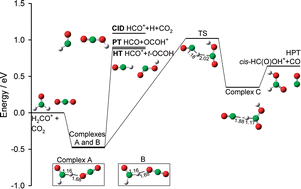The effects of collision energy (Ecol) and five different modes of H2CO+ vibration on the title reaction have been studied over the center-of-mass Ecol range from 0.1 to 3.2 eV, including measurements of product ion recoil velocity distributions. Electronic structure and Rice–Ramsperger–Kassel–Marcus calculations were used to examine properties of various complexes and transition states that might be important along the reaction coordinate. Two product channels are observed, corresponding to Hydrogen Transfer (HT) and Proton Transfer (PT). Both channels are endothermic with similar onset energies of ∼0.9 eV; however, HT dominates over the entire Ecol range and accounts for 70–85% of the total reaction cross section. Both HT and PT occur by direct mechanisms over the entire Ecol range, and have similar dependence on reactant vibrational and collision energy. Despite these similarities, and the fact that the two channels are nearly isoenergetic and differ only in which product moiety carries the charge, their dynamics appear quite different. PT occurs primarily in large impact parameter stripping collisions, where most of the available energy is partitioned to product recoil. HT, in contrast, results in internally hot products with little recoil energy and a more forward–backward symmetric product velocity distribution. Vibration is found to affect the reaction differently in different collision energy regimes. The appearance thresholds are found to depend only on total energy, i.e., all modes of vibration are equivalent to Ecol. With increasing Ecol, vibrational energy becomes increasingly effective, relative to Ecol, at driving reaction. For HT, this transition occurs just above threshold, while for PT it begins at roughly twice the threshold energy.


 Please wait while we load your content...
Please wait while we load your content...